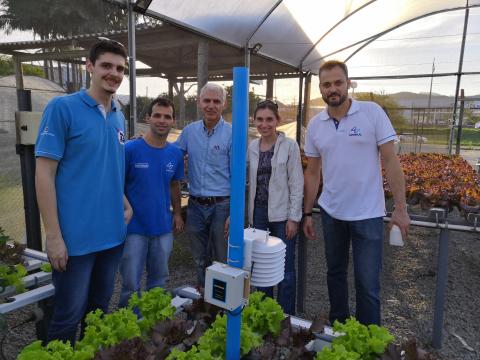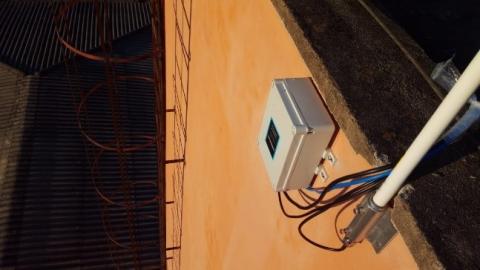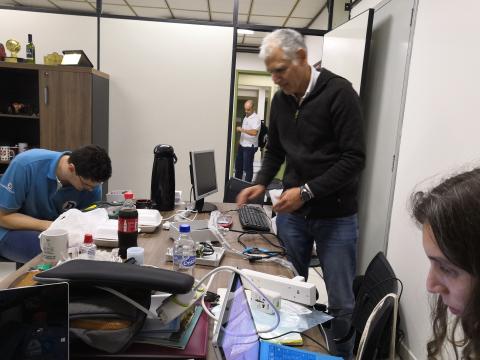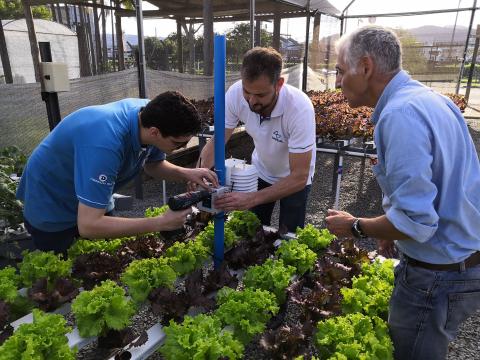The project BRIDGE-TESC brings together an international team of experts from academia and private sector to work in the co-development of technological solutions that can help to close the technology access gap in the agricultural sector in the State of Santa Catarina (Brazil).
BRIDGE-TESC: Technological Empowerment for family-farming agriculture in Santa Catarina
BRIDGE-TESC is a pilot project that brings together an international team of experts from academia and private sector to work in the co-development of technological solutions that can improve agricultural and industrial processes in the State of Santa Catarina (Brazil). The project includes three universities and a start-up: University of Cambridge (UK), University of the South of Santa Catarina (UNISUL, Brazil), Federal University of Santa Catarina (UFSC, Brazil) and Camnexus Ltd., a UK start-up. The project has four team leaders, one from each institution:
- PI: Dr Pablo Salas (C-EENRG, University of Cambridge, UK)
- Co-I: Dr Jessica Ocampos (Camnexus Ltd, UK)
- Co-I: Prof Baltazar Guerra (UNISUL, Brazil)
- Co-I: Prof Cristiane Derani (UFSC, Brazil)
About the Project
The project BRIDGE-TESC gathers multidisciplinary expertise to tackle the technology access gap currently existing in the family-farming sector of Santa Catarina (SC). The project builds on the already successful multidisciplinary and equitable research partnership between C-EENRG, UNISUL, UFSC and Camnexus under the research project BRIDGE, which focuses on the resilience of the Brazilian Food-Water-Energy nexus to global environmental and economic change.
BRIDGE-TESC has three main objectives:
- Support the sustainable and low-cost production of food using a solar hydroponic greenhouse prototype developed by UNISUL in BRIDGE.
- Support the improvement of agricultural practices in SC by implementing a prototype 'Internet of Things' (IoT) sensor network for agriculture. The data from the environmental variables obtained with this network will be used by the research partners to improve agricultural practices in vulnerable communities of the region.
- Improve the competitiveness of family farming in SC by closing the technology access gap and by fostering the implementation of local technology. The project fosters the development of specialised low-cost ICT technologies for improving agricultural productivity by engineering students of UNISUL and UFSC.
Figure 1 presents a diagram with the main components of the project. With the support of the University of Cambridge (top right), the two Brazilian universities, UNISUL and UFSC, joined efforts to implement an IoT network with gateways in two cities: Florianopolis (UFSC, bottom right) and Tubarão (UNISUL, bottom left). The implementation of the IoT network was led by Camnexus (centre of the diagram), using its early stage prototype network based on LoRaWAN technology. The network in Tubarão includes nodes installed in the solar hydroponic greenhouse prototype developed by UNISUL under the project BRIDGE (bottom left). A smaller scale greenhouse, with IoT technology in it, will be installed in a public school in Tubarão (top left), and its impact will be studied by researchers from DESIS (Centre for Studies on Sustainable Economic Development and Social Innovation) at UFSC.
In 2018, UFSC was awarded with the CAPES-PrInt programme, a project funded by CAPES - the Coordination of Improvement of Higher Education Personnel - to support the internationalisation of research at UFSC (hence the name, CAPES - Project for Internationalisation or ‘PrInt’). C-EENRG is one of the international partners of the CAPES-PrInt programme. In this context, the platform being developed under BRIDGE-TESC is expected to remain operative beyond the end of the project, with the support of the ongoing CAPES-PrInt (2019-2022) of UFSC (middle right of the diagram).
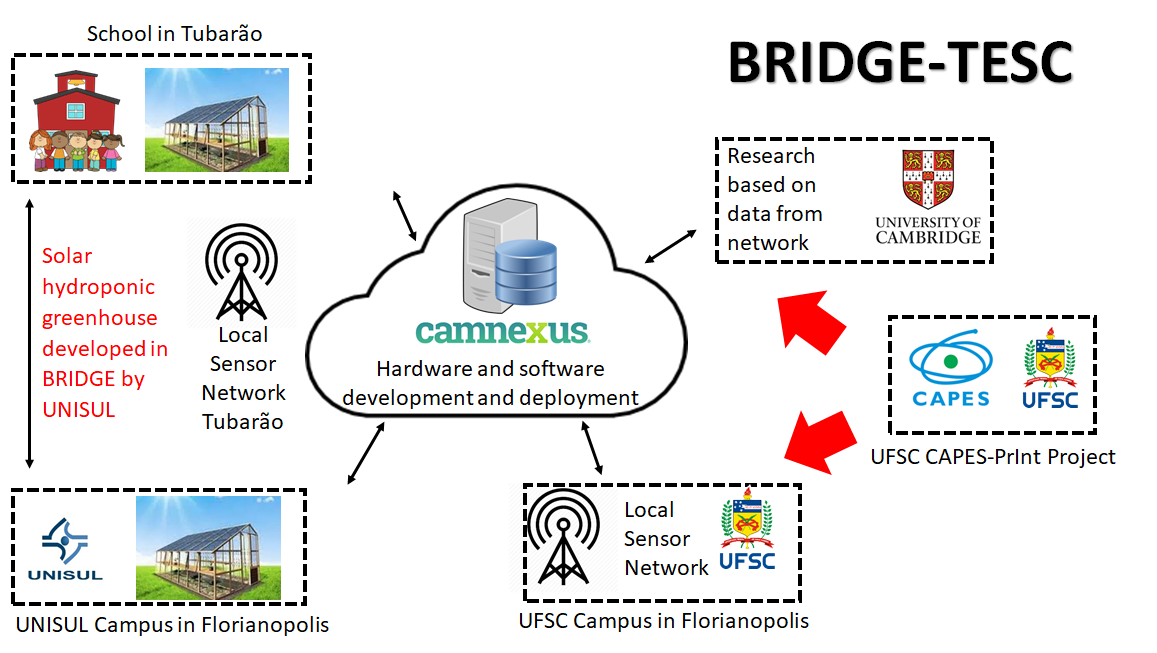
Diagram explaining the main components of the project BRIDGE-TESC.
The details about the pilot and the role of each partner of the project are described below. First, we describe the deployment of the IoT network in Santa Catarina, specifically in the cities of Tubarão and Florianopolis. Second, we describe the capability building work developed after the infrastructure was deployed, within UNISUL and UFSC. Third, we describe the work to be done in a local school in Tubarão in a combined effort UNISUL-UFSC. And finally we describe some of the future opportunities this project can bring.
Deployment of the IoT Network
UINISUL Tubarão and the solar hydroponic greenhouse
In 2018, the University of the South of Santa Catarina (UNISUL) designed and implemented a solar hydroponic greenhouse in its main campus located at the city of Tubarão. This implementation was one of the BRIDGE pilot projects, which aimed to evaluate a more sustainable production of food using solar power and minimising the use of fresh water. In BRIDGE-TESC, we proposed to use the IoT sensor network developed by Camnexus for monitoring the performance of the greenhouse for research purposes. The installation of the IoT network in UNISUL took place in June 2019, under the lead of UNISUL Professors Baltazar Guerra and Celso Albuquerque.
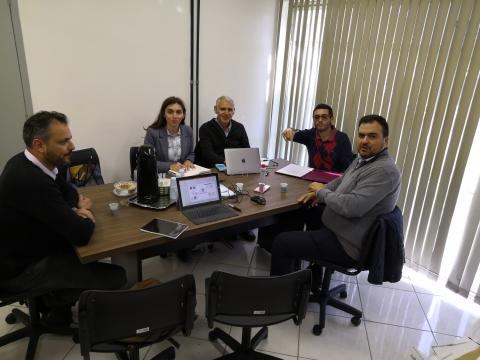 |
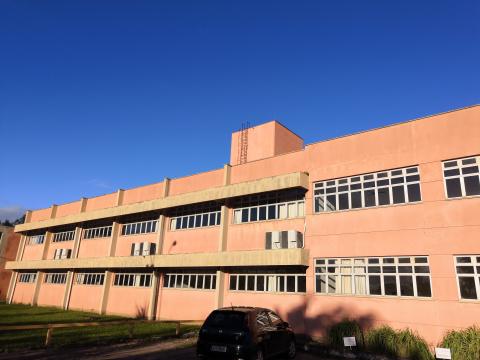 |
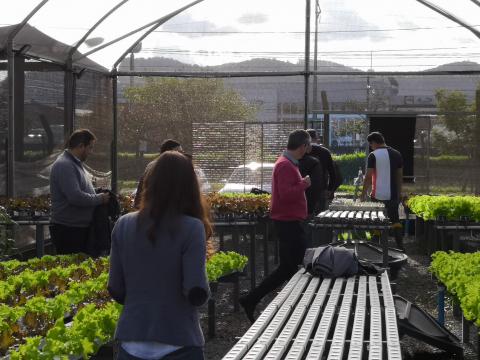 |
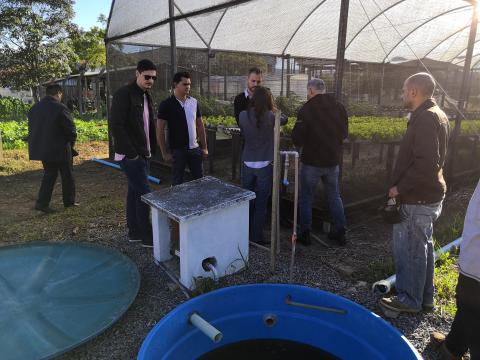 |
Meeting and technical visit in preparation for the installation of the IoT network in Tubarão. Top left: Meeting at UNISUL. From right to left Prof. Baltazar Guerra (UNISUL), Prof Celso Albuquerque (UNISUL), Juan Carlos Ocampos (Camnexus), Dr Jessica Ocampos (Camnexus), Prof. Juliano Cesconeto (UNISUL) and Dr Pablo Salas (C-EENRG, taking the photo). Top right: UNISUL building identified as the best option to install the IoT antenna. Bottom row: Technical visit to the solar hydroponic greenhouse before the installation.
|
|
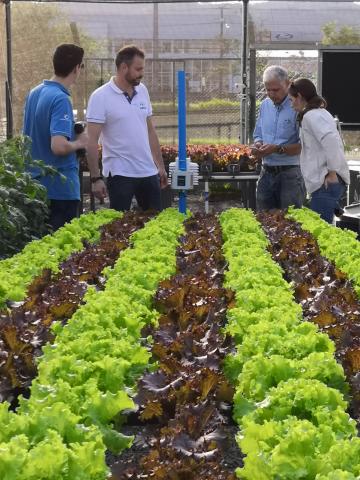 |
Installation of the IoT equipment at UNISUL Tubarão. Top left: Team that installed the meteorological station within the solar hydroponic greenhouse. From right to left Prof. Juliano Cesconeto (UNISUL), Dr Jessica Ocampos (Camnexus), Juan Carlos Ocampos (Camnexus) and Rafael Durante (UNISUL). Right: The team looking at the data from the meteorological station in the mobile phone, after the installation. From right to left Dr Jessica Ocampos, Juan Carlos Ocampos, Prof. Juliano Cesconeto and Rafael Durante. Bottom left: gateway and antenna installed at the top of the building showed in the pictures above.
Currently, the solar hydroponic greenhouse at Tubarão is being monitored remotely, using the IoT network. Since the beginning of its operation (June 2019), the pilot in Tubarão is providing real-time data of the greenhouse's internal climate, in-feed water quality and nutrients, and irrigation water level. Data processing and alerts have helped improvement of practices in the daily operation with impact in savings and productivity of the hydroponic farm.
UFSC Florianopolis
The IoT network has another gateway installed at the main campus of the Federal University of Santa Catarina (UFSC), in the city of Florianopolis. The installation took place at the top of the Technology Centre of UFSC (CTC Building, see pictures below). The work was led by Juan Carlos Ocampos from Camnexus. The team was supported by Gabriel Manoel and Beto, under the coordination of Prof. Carlos Montez, all of them from UFSC. Prof. Montez is the technical counterpart of UFSC within the project BRIDGE-TESC.
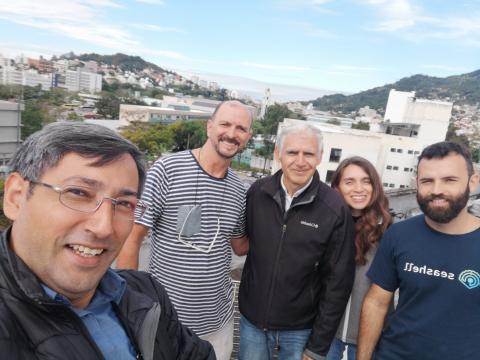
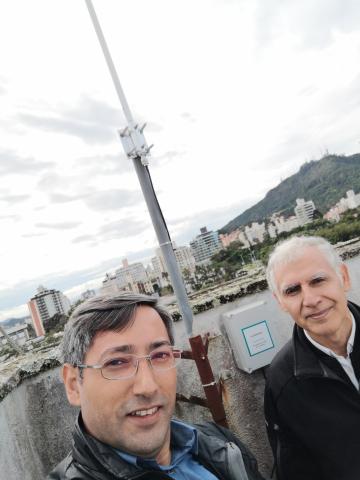
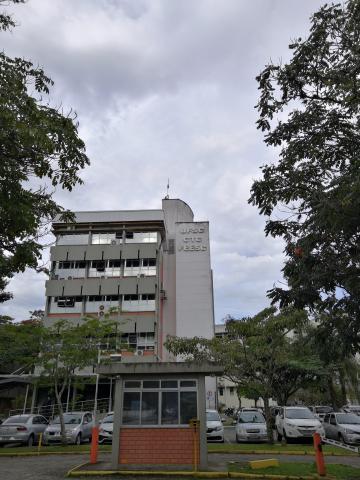
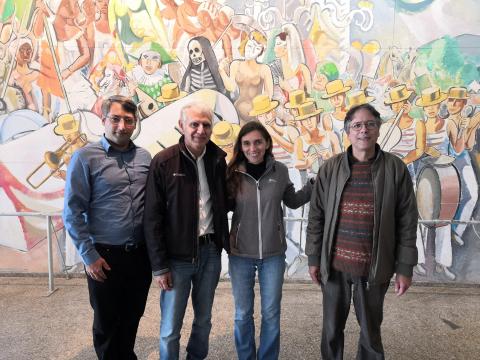
Installation of the IoT antenna within the UFSC campus at Florianopolis. Top: the team doing the installation. From right to left Gabriel Manoel (UFSC), Dr Jessica Ocampos (Camnexus), Juan Carlos Ocampos (Camnexus), Beto (UFSC) and Dr Pablo Salas (C-EENRG). Middle left: Juan Carlos Ocampos and Dr Pablo Salas posing in front of the installed gateway and antenna. Middle right: Picture of Beto (at the top of the building) working in the installation of the antenna. Bottom: Picture with Professor Carlos Montez (UFSC) who is the technical counterpart of USFC within BRIDGE-TESC and coordinated the installation work.
Training
Aiming to close the technology access gap in Santa Catarina, the project BRIDGE-TESC included capacity building sessions for engineering students at UNISUL and UFSC. The idea is to develop pilots training that will become part of permanent engineering courses. In this way, academic and students of UNISUL and UFSC can make use of the infrastructure, that will remain after the end of the project. The long-term objective is to create the training tools for the new generations of engineers, so they can keep working on the improvement of agricultural and industrial processes in Santa Catarina.
Training at UNISUL
Prof. Juliano Cesconeto became the technical counterpart in charge of the IoT infrastructure at UNISUL. With the help of the students Rafael Durante (electrical engineering) and Romulo Moya (agronomy), Prof Cesconeto and the team of Camnexus (Dr Jessica Ocampos and Juan Carlos Ocampos) installed, configured and tested the IoT equipment at the UNISUL campus of Tubarão. The team of Prof Cesconeto received direct training from Camnexus regarding each of the equipment installed at UNISUL, as well as the software platform being used for extracting the data.
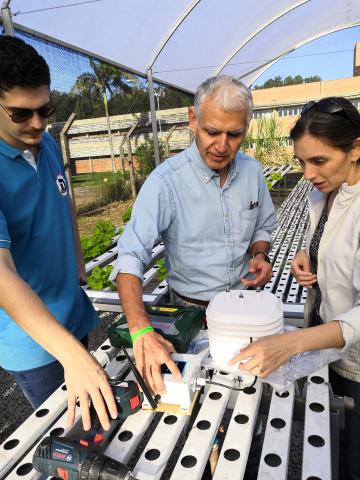 |
|
The team of Prof Cesconeto working together with Camnexus in the installation of the IoT network at UNISUL.
With the IoT equipment installed at UNISUL, the next step was to train the potential users of the platform. With this purpose, a training session was organised by Prof Celso Albuquerque and by Prof Francisco Duarte de Olivera, coordinator of Electrical Engineering at UNISUL. More than 60 students and academics attended the workshop.
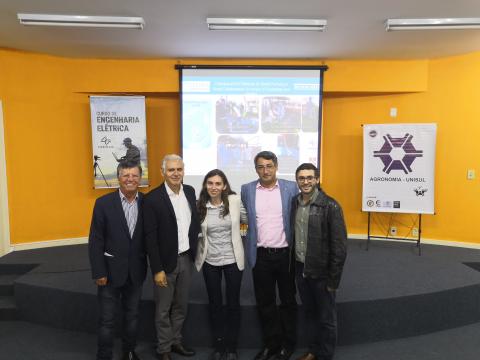 |
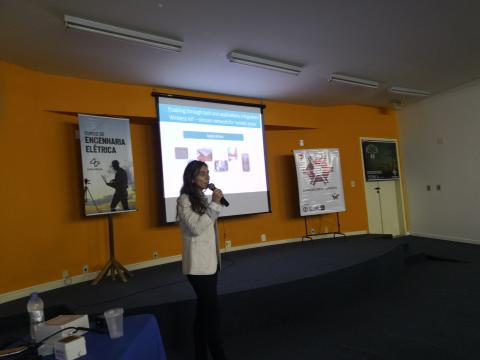 |
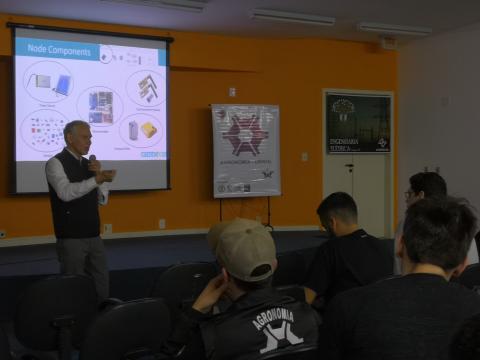 |
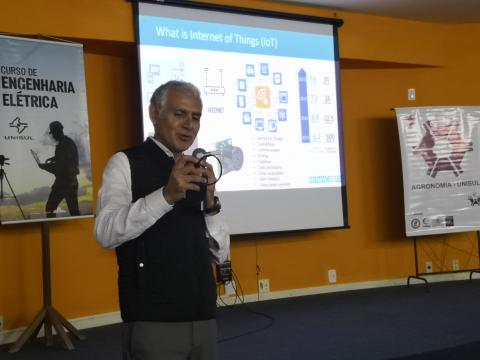 |
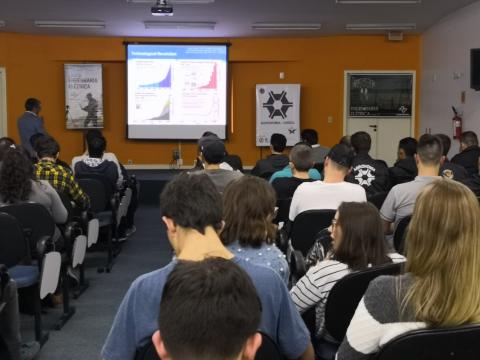 |
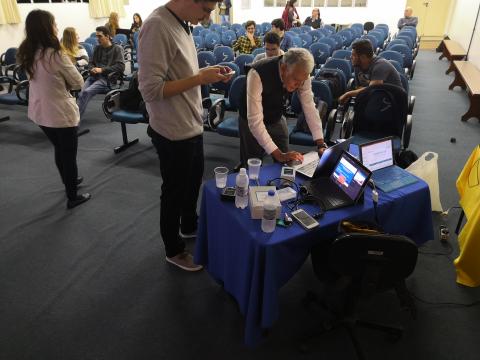 |
BRIDGE-TESC training session prepared for the academics and students of UNISUL. Bottom right: Juan Carlos Ocampos (Camnexus) and Rafael Durante (UNISUL) preparing the equipment. Bottom left: Session by Dr. Pablo Salas (C-EENRG). Middle right and left: Session by Juan Carlos Ocampos. Top right: Session by Dr Jessica Ocampos (Camnexus). Top left: organising team, from right to left Prof Celso Albuquerque (UNISUL), Dr Pablo Salas, Dr Jessica Ocampos, Juan Carlos Ocampos and Prof Francisco Duarte de Olivera (UNISUL).
Training at UFSC
At the Technology Centre (CTC) of UFSC, within the Department of Automation and Systems and the Department of Electrical and Electronic Engineering, there are several academics working on the development of IoT technology. Based on the existing capability, in BRIDGE-TESC we designed tailored training sessions for different levels of users:
- An introductory session for the leaders of the CAPES-PrInt programme. In particular, the leaders from the ‘Digital Transformation: Industry 4.0 and Services’, ‘Human Health’ and ‘Environmental Sustainability’ were invited to know more about the project, so they could identify potential areas of research collaboration using the new IoT platform. This session was organised and presided by the Director of the CAPES-PrInt programme, Prof Cristiane Derani, who is the Co-I of BRIDGE-TESC.
- An intermediate and an expert hands-on session for people interested or with experience working with IoT devices. These sessions were organised by Prof Ricardo Rabelo, Prof Max Queiroz and Prof. Carlos Montez, all of them from the Department of Automation and Systems.
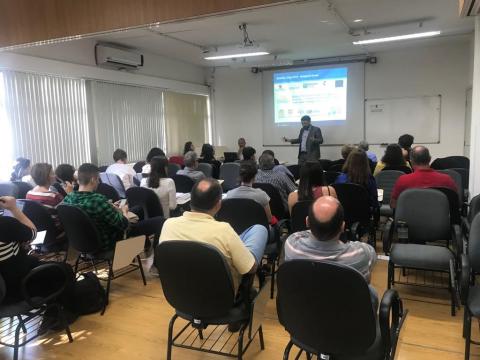 |
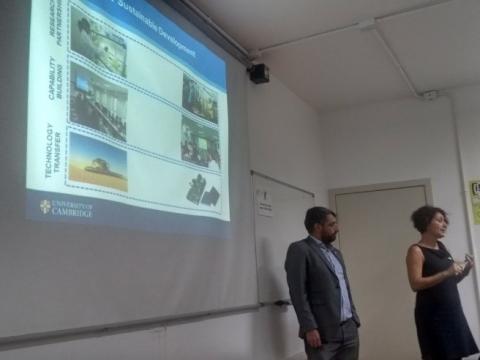 |
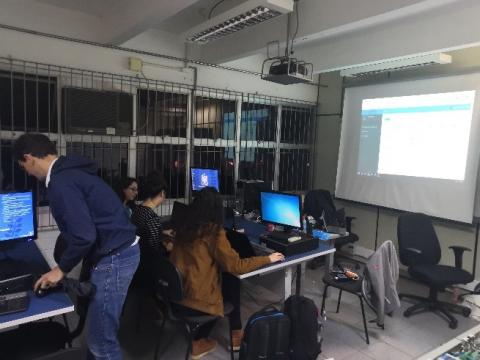 |
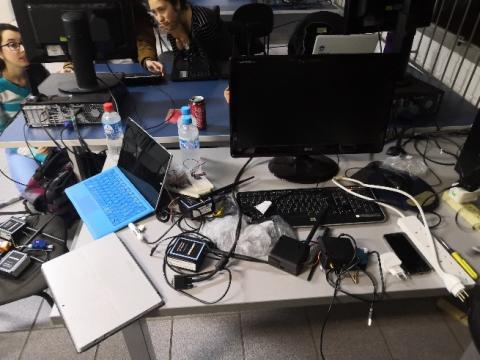 |
Top row: Introductory session for the leaders of the CAPES-PrInt programme at UFSC. The session was organised by Prof Cristiane Derani (top left picture), Director of the CAPES-PrInt programme and Co-I of BRIDGE-TESC. Bottom row: Training sessions for intermediate and advanced users of IoT. The sessions took place at the laboratory of the Department of Automation and Systems, organised by Prof. Ricardo Rabelo, Prof Max Queiroz and Prof. Carlos Montez.
Research programme with local school
One of the goals of BRIDGE-TESC is to have an impact in the local community, beyond the academic partners UNISUL and UFSC. As shown in figure 1, the project includes the installation of a small-scale replica of the solar hydroponic greenhouse of UNISUL in a public school in Tubarão, complemented with IoT equipment to measure its performance. The team at DESIS - Centre for Studies on Sustainable Economic Development and Social Innovation - at UFSC prepared a research programme to be developed in parallel with the installation of the equipment. The research programme aims to identify the social impacts that the technological intervention will have in the local community connected to the school. The research at the school will be directed by Prof Edison da Rosa, Director of DESIS, with the help of Debora Bernett. The programme will be implemented in close coordination with the team at UNISUL, which is leading the implementation of the new solar hydroponic greenhouse at the local school, under the direction of Prof Baltazar Guerra (Co-I of BRIDGE-TESC) and Prof Celso Albuquerque Junior (UNISUL).
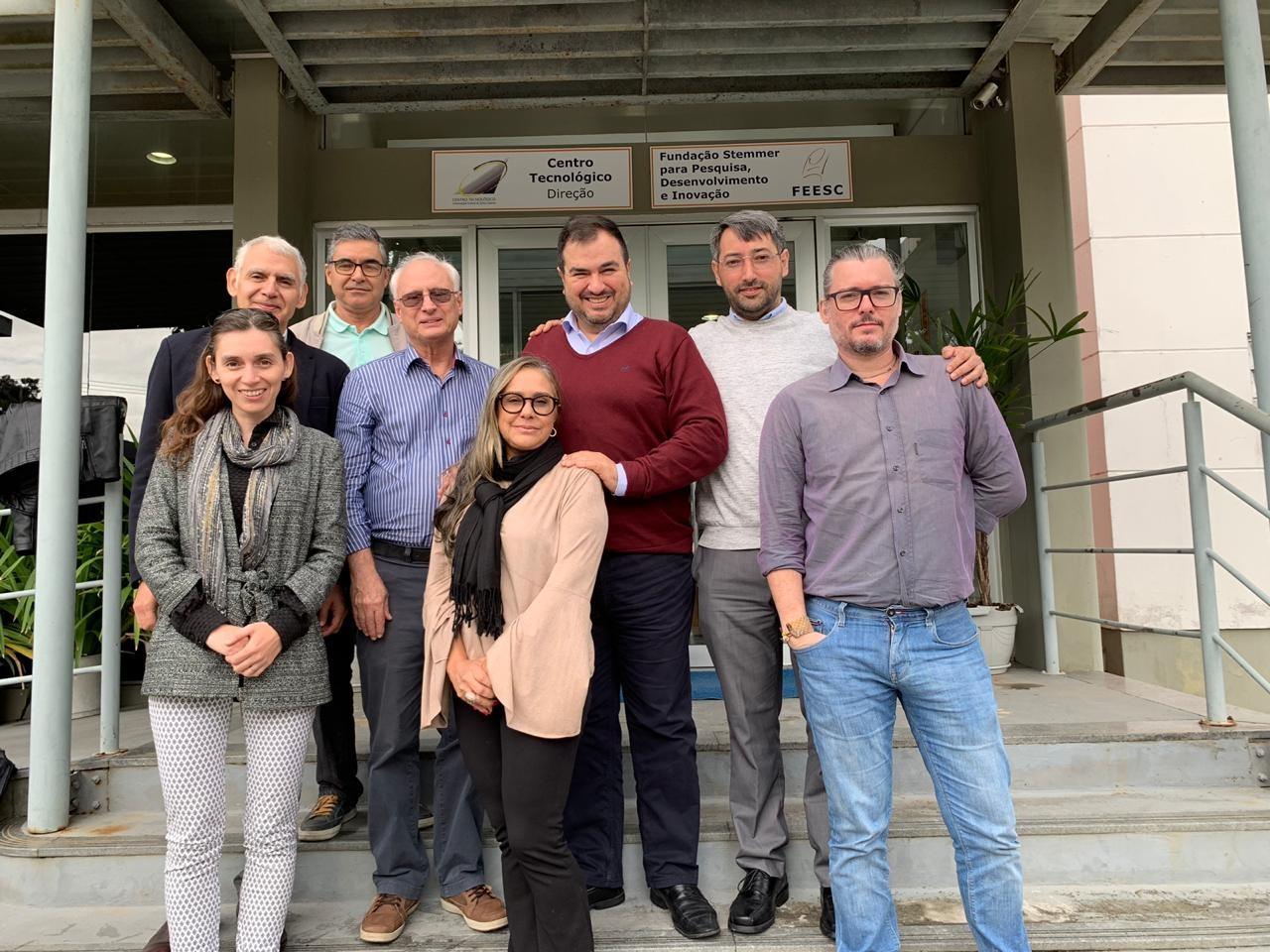
Meeting with Prof Baltazar Guerra and the DESIS team, to coordinate the research programme with the local school. From bottom left to right, front row: Dr Jessica Ocampos (Camnexus), Debora Bernett (DESIS), Eduardo Cruz (DESIS). Middle row: Juan Ocampos (Camnexus), Prof Edison da Rosa (DESIS), Prof. Baltazar Guerra (UNISUL), Dr Pablo Salas (C-EENRG). Back row: Vicente Sandrini Pereira (DESIS).
Identification of new opportunities, beyond BRIDGE-TESC
The long-term objective of BRIDGE-TESC is to improve the competitiveness of family farming in SC by closing the technology access gap and by fostering the implementation of local technology. Working in this direction, BRIDGE-TESC included a series of meetings with strategic stakeholders, to search for potential collaboration opportunities. Some of these activities are described below.
Workshop with UFSC researchers leading the CAPES-PrInt programme
Following the introductory session for the leaders of the CAPES-PrInt programme (see section 'Training at UFSC' above), a tailored workshop was designed for the groups that could be particularly benefited form using the infrastructure developed under BRIDGE-TESC. The attendees included people from Computing Sciences, Food Engineering, Aquaculture and Power Electronics. The workshop included a detailed description of the infrastructure developed under BRIDGE-TESC, and a group working session to identify specific ways in which the attendees could use the infrastructure in their respective research areas. The workshop finished with a discussion of potential funding opportunities, for local (Brazil) as well as international research projects.
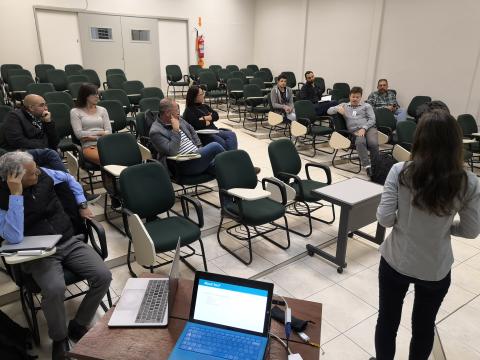 |
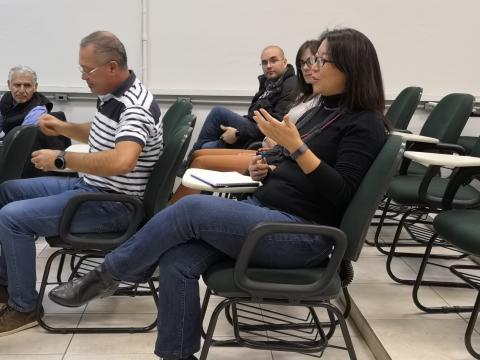 |
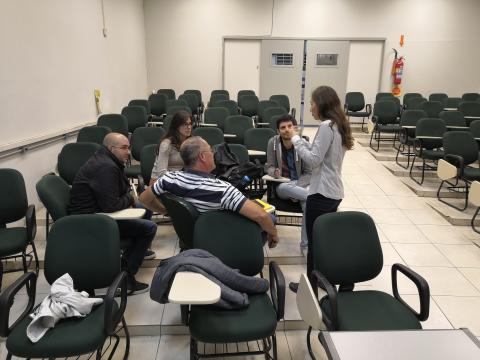 |
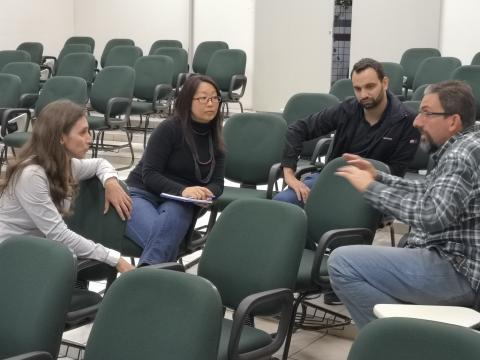 |
Workshop session with researchers that could be particularly benefitted by the BRIDGE-TESC infrastructure at UFSC.
The researchers attending the workshop were mostly from campuses located in the island of Florianopolis. Another group of researchers from UFSC Ararangua (220 km to the South of Florianopolis) was interested in attending the workshop, to learn how they could use the IoT network developed under BRIDGE-TESC in their research projects. Unfortunately, due to the geographical limitations, they were not able to attend. Consequently, we organised a skype session with them, to explain how they could make use of the platform, and how potential collaborations could be developed.
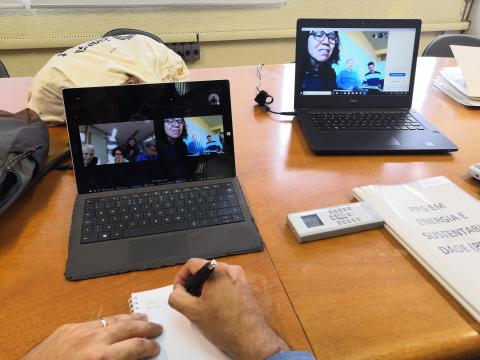 |
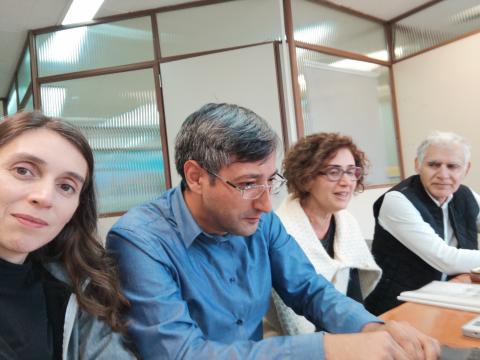 |
Skype meeting with the CAPES PrInt team of UFSC Ararangua. The meeting was presided by Prof Cristiane Derani, Director of the CAPES PrInt programme at UFSC and Co-I of BRIDGE-TESC.
Visit to the Power Electronics Institute at UFSC
The tailored workshop described in section 5.1 helped us to identify ways in which the team at the Power Electronics Institute (INEP, UFSC) could benefit from the infrastructure developed by the BRIDGE-TESC project. After attending the CAPES PrInt workshop, Prof Andre Luis Kirsten invited us to the INEP lab. There, he showed us the systems UFSC is developing to solve some of the challenges of the energy industry at Santa Catarina. After the visit, it became clear that the technological solutions being developed at INEP could be enormously benefitted by adding the IoT telecommunication layer developed within the BRIDGE-TESC project. Thanks to the workshop and the meeting, now specific collaboration opportunities are being discussed between the different partners.
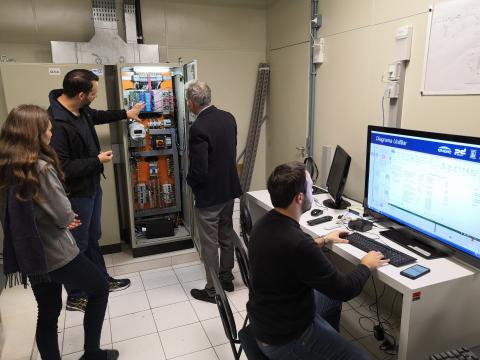 |
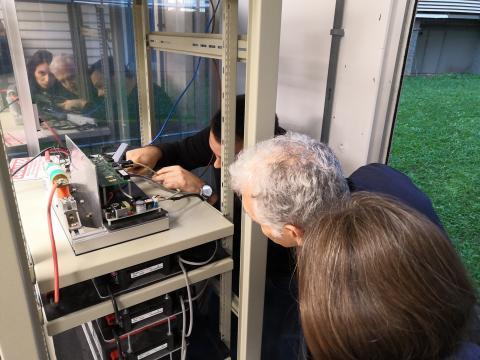 |
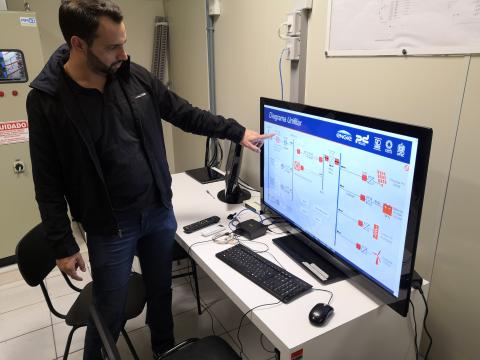 |
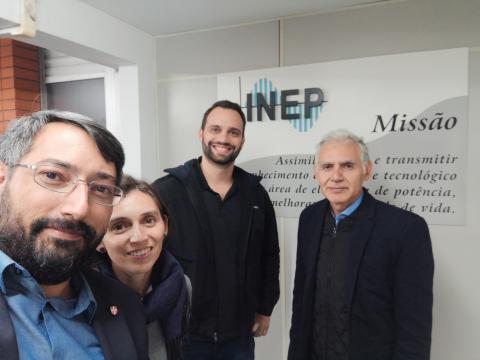 |
Visit to the laboratory of the Power Electronics Institute (INEP) at UFSC, to discuss specific ways in which they could be benefited by using the infrastructure developed under BRIDGE-TESC. Visit organised by Prof Andre Luis Kirsten.
Engaging with the wider innovation ecosystem of Santa Catarina
Taking advantage of the extensive networks of stakeholders of UFSC and UNISUL, we decided to present the project BRIDGE-TESC to two relevant stakeholders of the Santa Catarina’s innovation ecosystem: ACATE – the Santa Catarina Association of Technology Companies – and SEBRAE – the Brazilian Service of Assistance to Micro and Small Enterprises. Both groups share a common goal with BRIDGE-TESC: closing the technology access gap of Santa Catarina. ACATE and SEBRAE showed great interest in the technological platform created through BRIDGE-TESC, because it can provide direct benefits to its members. Therefore, we agreed in pursuing further conversations to search for potential collaborations.
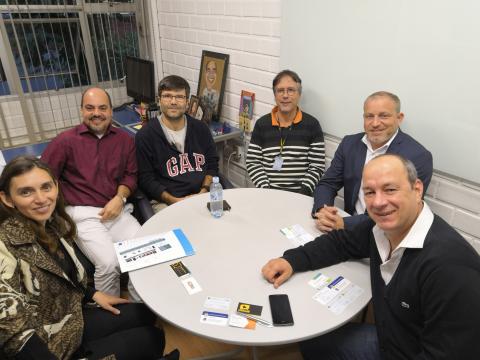 |
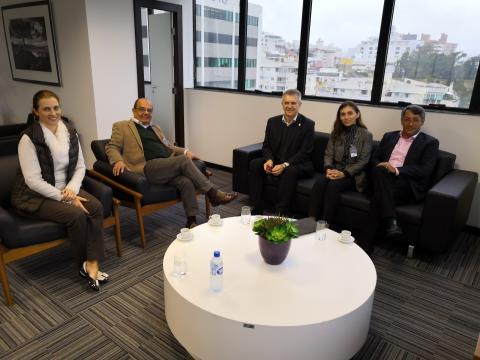 |
Meetings with two relevant stakeholders of the innovation ecosystem of Santa Catarina. Left picture: meeting with the IoT Coordinators of ACATE, Fabiano Wiggers (bottom right) and Hamilton Avinco (top right). The other attendees were (from left to right) Dr Jessica Ocampos (Camnexus), Prof. Ricardo Rabelo (UFSC), Prof Richard D Souza (UFSC), Prof. Carlos Montez (UFSC) and Dr Pablo Salas (taking the picture). Right picture: meeting with the Director of Finance and Administration of SEBRAE, Anacleto Ortigara (middle). The other attendees were (from right to left) Dr Pablo Salas (C-EENRG), Dr Jessica Ocampos (Camnexus) and Prof Alvaro Lezana (UFSC).

